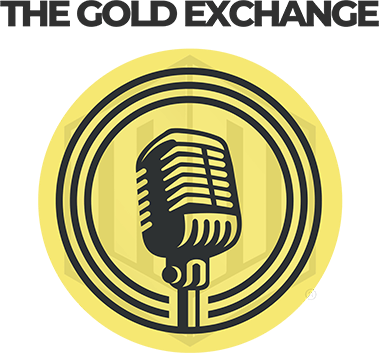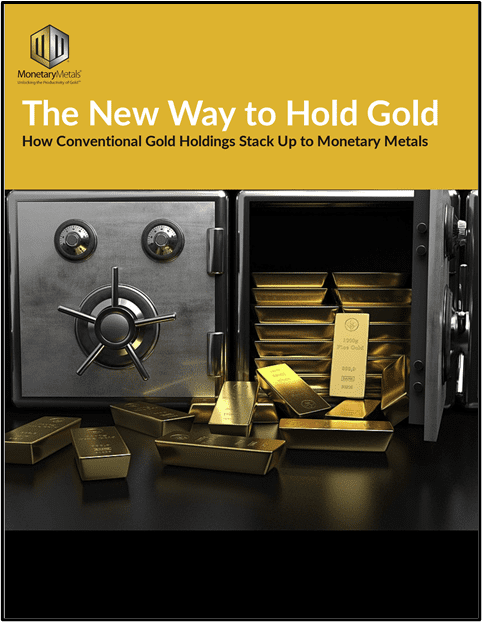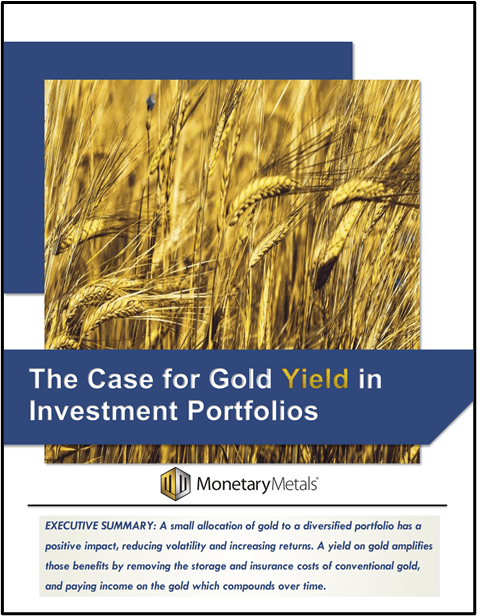Transcript
Jeff Clark joins the podcast to discuss the importance of gold in a portfolio, the impact of higher interest rates, black swan events, and what to look out for in a downturn. Jeff Clark also shares insights on the unique qualities of silver, mining stocks, and how to hit paydirt!
Additional Resources
Jeff Clark
TheGoldAdvisor.com
The Case for Gold Yield in Investment Portfolios
Paydirt Book
Podcast Chapters
[00:00:00]: Jeff Clark
[00:00:32]: Rate Impact
[00:02:43]: Potential Rate Cuts
[00:03:03]: Possibility of Negative Interest Rates
[00:04:12]: Black Swan Events
[00:06:10]: Unknown Unknowns
[00:08:15]: Silver is Unique
[00:09:39]: Precious Metals
[00:12:49]: Gold Allocation
[00:16:09]: Subscribe!
Transcript:
Ben Nadelstein:
Welcome back to the Gold Exchange Podcast. My name is Ben Nadelstein. I’m joined today at the New Orleans Investment Conference by Jeff Clark of thegoldadvisor.com. Jeff, how are you doing today?
Jeff Clark:
Great. Thanks for having me, Ben. I’m glad to be here!
Ben Nadelstein:
We love talking with you! Jeff, let’s start with a high level overview. 5% interest rates. Most people said this would be a two-mega-ton bomb on the economy. The stock market would crash, inflation would be out of control. Yet here we are, low unemployment. We hit about 3.89 % today and inflation seems to be cooling and stock market seems to be all right. What is your response to critics who say at 5% rates, I thought we were going to be in a nuclear war zone?
Jeff Clark:
That’s a fair question. A lot of people did think that. Maybe this book is not done being written, though. I think there are still other factors that could impact things. Inflation is coming down. But if you look back at the 1990s, the most comparable we have, inflation did a two step. It went up, came down and then went back up again, even though Volker was being very aggressive with raising rates. The effect is going to be, does the Fed keep rates higher for longer like they claim they’re doing? One fact that I would like to pass along is if you look back at rate raises and then when they reverse course and start to cut them, the average time, believe it or not, between the last rate hike and the first rate cut is five months. That’s the historical average going all the way back to the 1960s. There’s not been one that’s been over a year. I think the Fed’s higher for longer mantra may not be able to play out, especially depending on what recession we get. But historically, if the last rate hike is in or about to be in, that tells us that the odds are high, they’ll actually be cutting in 2024.
Ben Nadelstein:
Now let’s talk about cutting really quickly. So if you look at a chart of interest rates, you’ll notice that we hit this zero point where we’re actually on a flat line on these zero % interest rates. Do you think that this next cutting cycle or pivot will actually go below that zero threshold? Do you think we will see nominal negative interest rates?
Jeff Clark:
It depends on how deep the recession is, and it depends if we have some other crisis going on at the same time. If there’s a monetary crisis, something with the debt, something with the dollar, the dollar is going to die, by the way, not by going down, as the milkshake theory guy says. It’s going to blow up because it goes too high and puts too much pressure on other countries. But at any rate, it could be some type of crisis. In fact, Ben, I looked back at all the crises going all the way back to the 60s, and I just listed them all. And I started examining them and I realized that about half of them were black swans. They were events that people weren’t predicting or looking for. So everybody’s talking about the recession and the Fed and the debt. I get it. All those things are important. They do impact gold, and they do impact the markets, obviously. I think the odds are reasonable that we could actually see a black swan in 2024, something nobody’s really looking for, and that could really blow up the markets.
Ben Nadelstein:
And that’s what we do talk about a lot on the podcast, is the unknown unknowns. Well, my name is Ben, I know that. Okay, then there’s the known unknowns. Well, I know that I don’t really know how bad it is in the commercial real estate market, but I know that I don’t know. But then there’s the unknown unknowns. The thing that you don’t even know that you don’t know. And that Black Swan event is something where a lot of investors, just by its very nature, will never know what hit them in 2008. It could have been mortgages. Housing always goes up. No one even thought to look at that. What do you think is something for people to at least start looking into now that we’re in 2023 heading into 2024?
Jeff Clark:
That’s a great question. I have some theories on what they could be, but the bottom line is you have to own gold going into this environment, whatever it may be. It could be a banking crisis. Maybe a bank blows up or something like that and the Fed has to step in. Maybe they resume money printing. Maybe the recession gets so deep they have to cut rates aggressively and go back down to this zero line you’re talking about. Something happens in Brazil. A butterfly flaps its wings in Brazil, as the famous saying is, and all of a sudden the market crashes in the US. There are a number of things that it could be the unknown unknowns. I don’t know what they are either. But what I do know is that the environment is so ripe for something like that, and that I am very glad that I own gold. In fact, my webmaster was praying for $1,800 gold because he wanted to buy more and get it cheaper. He didn’t get it at $1,800. I don’t know if we’re going to see $1,800a dollar gold again. So we’ll see. But the point is you need to be prepared for that because the environment is very susceptible to something like you’re talking about.
Ben Nadelstein:
Yeah. And I think the analogy might be you are in a very dangerous environment whether that be in the jungle and alligators and spiders and snakes. It’s unclear which of these problems. It could be that a tree falls on your head, but you are in a dangerous environment. And so right now that spark is just waiting to light. Now that could be commercial real estate, it could be a whole host of things, including things we’re not paying attention to.
Jeff Clark:
The difference is taking a walk in your own neighborhood that’s generally safe versus taking a walk in a jungle. You are more susceptible to something happening to you in the jungle than you are in your neighborhood. We’re in the jungle right now.
Ben Nadelstein:
Let’s talk about this 5 % rate environment. We’ve never even been in a real positive rate environment in so long that people who are young like myself have never even thought Oh, my gosh, a savings account can pay you 5 %. Do you think that this 5 % cycle, this higher for longer cycle, do you think that that changes how investors are going to start allocating capital? Or do you think that most people are thinking, I know we’re going back to zero bound?
Jeff Clark:
They’re going to allocate capital to these five % rates at their bank or whatever. I even bought a CD at 4.5 %, I think, at three months ago because I thought, wow, this is a gift. I can just let it sit there and earn money. So yes, I’ve done that. What will push people into gold isn’t something there. It’s going to be something in terms of an event, a crisis. Look at the geopolitical conflict that we have right now and what that did to gold. Gold may soften when that eases off, but it’s going to be something else that pushes people more into gold. Some crisis, fear, uncertainty. That’s when people go to gold. And I think, like we’ve talked about that, that environment is here right now.
Ben Nadelstein:
And let’s talk about the two monetary metals, which are gold and silver. We’ve touched a little bit about gold, but do you see that silver has a different narrative, or do you think it’s just junior gold?
Jeff Clark:
That’s a good way to put it. Silver has its own DNA. Some claim that it’s really just an industrial metal now. Industrial use of silver is trending up, and it’s going to continue to do that. There are new uses found for silver, literally every month. So that’s going to continue up. But silver does respond to any type of monetary or financial crisis like we saw in COVID. The COVID bounce was tremendous. Gold rose 40 %, but silver rose 140 % just in that COVID bounce, that five month period. So silver does have its own DNA, though. It’s what I like to call boring, boring boom, because it just sits there and does nothing for long periods of time, like it’s been doing since the peak in 2020, but there will be another spike in silver because history says it does spike. That’s its DNA. So when gold begins to move, whatever the reason may be, silver may not move initially, but it will catch up. And historically it’s passed gold in a percentage basis every single time.
Ben Nadelstein:
Now, I want to talk about some of the way that you’ve come to understand the gold and silver come to this analysis. How have you educated yourself on the precious metals and how they operate their DNA? Where did you learn all this stuff?
Jeff Clark:
Well, my dad was actually a gold prospector, so I was in the business for a little bit of time. And then I became a newsletter writer, got hired at Doug Casey’s firm way back in the day. I was actually trained by Lobo Tegray on newsletter writing. So he’s my mentor. I give him credit for that. I’ve been doing this for a long time and, of course, come across a number of sources and people and that thing. I felt like I needed to actually even write a book on it. So I did write a book to educate or provide some type of insight to the retail investor on how to invest in mining stocks. It’s been a long journey. It’s been a fun journey. It’s been a profitable journey, believe it or not, in spite of what’s happening right now. So this… Yeah, it’s been great.
Ben Nadelstein:
Now let’s talk a bit about PayDirt, your book. What is the difference for someone who might know nothing about gold or silver, let alone mining? Most people think, well, if I own gold, okay, I get how that works. You just buy the shiny metal, right? But how is it different owning mining companies than it is the actual physical metal?
Jeff Clark:
Well, physical metal is your defense. That’s your shield. That’s your protection. That’s money better than the money we have today, meaning the US dollar or Canadian dollar. So you have to own gold, especially in the environment we’re in right now. In fact, long term studies show you need to own 20 % of your entire portfolio in physical metal somewhere. I think investors would really benefit by being a little overweight physical gold right now. What I did with Paydirt is I assumed that you knew nothing. We start at ground zero and go from there. It’s a fun read. I start with the scariest mine that I’ve ever been in and go from there, teach people how mining works, how building a mine works. And then we start actually building a list of mining stocks that you potentially might want to look at as you’re reading. There are 16 outside experts in the book. I included them in the book as well. It’s very informative. And the thing is, it’s very clear. Here. You’ll read this book and you know exactly what you need to do, exactly what to look at, exactly when you would not pick a mining stock.
Everybody in the book, including myself, are very clear about that. But it starts from ground zero. So if you don’t know anything, that’s fine. This book will take you through it.
Ben Nadelstein:
And I do like that allocation talk because a lot of people say, Well, I know I should have some gold, but is it 1 %? 5 %? 50 %? I don’t really know. We wrote a white paper called The Case for Gold Yield in a Portfolio asking this question, hey, how much gold should you have in a portfolio? And if it has yield, how does that change the equation? So obviously we can never and do never give investment advice. But let’s talk about allocation for a second. What does it look like the difference between someone who has one %, five %, maybe like a 20 % allocation to gold. What is the real benefit there?
Jeff Clark:
The benefit is going to be that gold rises in uncertain times, in scary times, bad events, whatever the case may be. But if 99 % of your other the rest of your portfolio is in stocks, even bonds, the 60-40 portfolio is not working. That is no longer a valid way to a strategy to invest. So if you only have 1% in gold, you have some protection with that. But if 99% of your portfolio is in 60, 40 or in real estate, that looks like it’s going to continue to get weaker, your that 1% is not going to shield you. Anything, in my opinion, anything below 5% is meaningless and not going to have much of an impact on your portfolio in a crisis event. Again, I think you need to push yourself more toward the 10%, 15%, 20%. That’s what long term studies show and we’re more vulnerable right now than we usually are.
Ben Nadelstein:
Now I want to ask you a quick question about inflation. A lot of experts predicted inflation would rise, that we would have structural inflation. Inflation is here to stay, was the quote. Do you see this inflation cooling as just a anomaly or do you think that we’re actually in a high inflation environment?
Jeff Clark:
I think inflation is going to stay. I think it’s higher than the CPI. Mike Maloney likes to call it the CP-LI. They do change how they calculate it. They’ve changed it so many times we actually lost count. It was something like 20 times that John Williams, the shadow stats is documented. So the formula keeps changing. Everybody knows that is higher than what they’re actually reporting in the CPI. If you compare to the 70s, like I mentioned, the CPIs could easily have another bounce, which would be interesting to see how the Fed reacts to that. So who knows? But I think there is precedents that inflation is done rising and there could be another spike.
Ben Nadelstein:
Now, final question as we end here. What’s something I should be asking all other guests of the Gold Exchange podcast when they come on.
Jeff Clark:
What’s something you should be asking them? I think your allocation question is great because I think some people do own a little bit of gold. There are people here, even at this conference, that own no gold. So what is the proper allocation in the current environment or the environment they see coming? I would be interested actually, in some of those responses. If it’s 1 % or zero, you don’t really need gold, or if it’s 20 % or if it’s 50 %, I would be interested to see what other people think. In my opinion, it should be around 20 %.
Ben Nadelstein:
Jeff, where can people find more of your work and find your website?
Jeff Clark:
It’s pretty easy. It’s thegoaldadvisor.com The book is there. My mining portfolio is there. You do need to sign up, create login credentials to view the portfolio, but it’s easy. It’s free. We don’t sell your email or anything like that. But everything I do is on that website, including mining stocks.
Ben Nadelstein:
Jeff, I want to thank you so much for coming on to the Gold Exchange podcast. It’s been a pleasure.
Jeff Clark:
It’s been great, Ben. Thank you, and please have me back.
Ben Nadelstein:
Absolutely. Thanks so much.
Additional Resources for Earning Interest in Gold
If you’d like to learn more about how to earn interest on gold with Monetary Metals, check out the following resources:
In this paper, we look at how conventional gold holdings stack up to Monetary Metals Investments, which offer a Yield on Gold, Paid in Gold®. We compare retail coins, vault storage, the popular ETF – GLD, and mining stocks against Monetary Metals’ True Gold Leases.
The Case for Gold Yield in Investment Portfolios
Adding gold to a diversified portfolio of assets reduces volatility and increases returns. But how much and what about the ongoing costs? What changes when gold pays a yield? This paper answers those questions using data going back to 1972.




